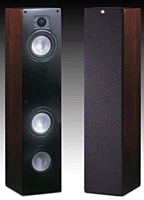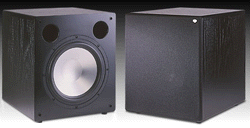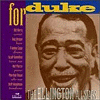This article appeared online September 2001 Audioholics.com
RBH Sound’s MC-6CT / TS-12AP Speaker System
By Brian Kahn
 RBH
Sound, named after chief designer Roger B. Hassing (not to
be confused with the late James B. Lansing) has recently risen up as a
contender in the highly competitive US loudspeaker market with a lineup
of high performance affordable music and theater speakers. RBH speakers
are known for their use of aluminum drivers like those found on Velodyne
and Monitor Audio speakers. RBH dresses up their speakers in ultra sexy
colors and veneer finishes not too far from what you’d expect from the
super boutique, high end loudspeaker manufacturers such as Wilson and
THIEL. The system I evaluated includes the MC-6T speakers and TS-12AP
powered subwoofer priced at $1099 pair (for cherry or semi gloss white
finishes, $999 in the black oak finish) and $799, respectively.
RBH
Sound, named after chief designer Roger B. Hassing (not to
be confused with the late James B. Lansing) has recently risen up as a
contender in the highly competitive US loudspeaker market with a lineup
of high performance affordable music and theater speakers. RBH speakers
are known for their use of aluminum drivers like those found on Velodyne
and Monitor Audio speakers. RBH dresses up their speakers in ultra sexy
colors and veneer finishes not too far from what you’d expect from the
super boutique, high end loudspeaker manufacturers such as Wilson and
THIEL. The system I evaluated includes the MC-6T speakers and TS-12AP
powered subwoofer priced at $1099 pair (for cherry or semi gloss white
finishes, $999 in the black oak finish) and $799, respectively.
 My
MC-6T and TS-12AP both came finished in a very high quality cherry
veneer veneer with removable, black grille covers. I was shocked when I
opened the boxes and saw how beautiful they looked. These speakers are
nearly furniture grade, which was a level of craftsmanship I wasn’t
expecting at these prices. The MC-6T is 40 inches high by 14.5 inches
and 9.5 inches deep and its driver complement consists of one, 1 inch
dome tweeter and three 6.5 inch woofers, all aluminum and proprietary in
design. The TS-12AP subwoofer is approximately 18 inches square and
features a single 12 inch driver driven by a built-in 160 watt
amplifier.
My
MC-6T and TS-12AP both came finished in a very high quality cherry
veneer veneer with removable, black grille covers. I was shocked when I
opened the boxes and saw how beautiful they looked. These speakers are
nearly furniture grade, which was a level of craftsmanship I wasn’t
expecting at these prices. The MC-6T is 40 inches high by 14.5 inches
and 9.5 inches deep and its driver complement consists of one, 1 inch
dome tweeter and three 6.5 inch woofers, all aluminum and proprietary in
design. The TS-12AP subwoofer is approximately 18 inches square and
features a single 12 inch driver driven by a built-in 160 watt
amplifier.
 Metal
drivers, normally only found in the most exotic of speaker designs, are
fairly rare in the realm of affordable speakers. The metal drivers
provide the desired pistonic linear motion sought and are less likely to
flex and distort than conventional drivers. These benefits do not come
for free however. Thankfully, the detriments of metal drivers just call
for more work on the part of the design team and do not negatively
affect the listener in this case. With metal drivers, especially those
utilizing the wide bandwidth made possible by their inherent stiffness,
there is the possibility that the operable bandwidth may overlap with
the drivers resonant frequency. RBH designers implement a system of
precise cross-overs to prevent this malady.
Metal
drivers, normally only found in the most exotic of speaker designs, are
fairly rare in the realm of affordable speakers. The metal drivers
provide the desired pistonic linear motion sought and are less likely to
flex and distort than conventional drivers. These benefits do not come
for free however. Thankfully, the detriments of metal drivers just call
for more work on the part of the design team and do not negatively
affect the listener in this case. With metal drivers, especially those
utilizing the wide bandwidth made possible by their inherent stiffness,
there is the possibility that the operable bandwidth may overlap with
the drivers resonant frequency. RBH designers implement a system of
precise cross-overs to prevent this malady.
Setup
Before I began any critical listening, I let the RBH's break in for a couple of weeks in my extra bedroom with a constant low level music source. Ultimately, I listened to my RBH’s in my two channel system exclusively, which is comprised of B&K PT-3 Pre-Amp, a B&K ST1400II (125 watt per channel), a Sunfire Subwoofer Jr., a Pioneer Elite PDR-19RW, and is connected with Audio Analysis cabling. The RBH’s were easy to connect with their nicely crafted 5 way binding posts which should be standard equipment on every $1,000 a pair loudspeakers but are strangely forgotten by lesser speaker manufacturers. The TS-12AP subwoofer had the entire gamut of connections, high level input and output, line level input and output, phase and level controls, and so forth.
RBH recommends positioning the MC-6T’s at least fifteen inches from the wall and seven feet apart from one another. I ended up with the back of the speaker cabinet a bit over a foot from the wall and the speakers seven feet apart. I positioned the TS-12AP just inside of the right speaker with the front of the TS-12AP a few inches forward of the MC-6T’s.
The Music
 I
used a variety of music while evaluating the RBH system including,.
Bill Berry’s For Duke mastered by Ken Kreisel (of M&K fame), Keb
Mo’s Slow Down (Okeh/550 Music), The Crystal Method’s Vegas (Outpost
Recordings), Eric Clapton’s Unplugged (Reprise), Elvis Presley’s Elvis
is Back (RCA/DCC) and a worthy new addition to my repertoire, St.
Germain’s Tourist (Blue Note).
I
used a variety of music while evaluating the RBH system including,.
Bill Berry’s For Duke mastered by Ken Kreisel (of M&K fame), Keb
Mo’s Slow Down (Okeh/550 Music), The Crystal Method’s Vegas (Outpost
Recordings), Eric Clapton’s Unplugged (Reprise), Elvis Presley’s Elvis
is Back (RCA/DCC) and a worthy new addition to my repertoire, St.
Germain’s Tourist (Blue Note).
 Overall,
I found the RBH’s to sound to be better than my expectations even with
the post-CEDIA show hype from our Publisher, Jerry Del Colliano who
heard and liked the MC-6CT’s in September – even under trade show
conditions. Having lived with extremely clean and open sounding Martin
Logan Scenario electrostatic hybrid speakers ($2,000 per pair) I was
expecting more coloration from a dynamic driver in a box enclosure. I
never heard the flaws I expected the hear based on my prejudices before I
listened to the RBHs.
Overall,
I found the RBH’s to sound to be better than my expectations even with
the post-CEDIA show hype from our Publisher, Jerry Del Colliano who
heard and liked the MC-6CT’s in September – even under trade show
conditions. Having lived with extremely clean and open sounding Martin
Logan Scenario electrostatic hybrid speakers ($2,000 per pair) I was
expecting more coloration from a dynamic driver in a box enclosure. I
never heard the flaws I expected the hear based on my prejudices before I
listened to the RBHs.
I could have been convinced that Eric Clapton was actually playing in my room when listening to "Before You Accuse Me" on Unplugged." Elvis’ rendition of "Fever" (or perhaps the story I saw in the National Enquirer at the grocery store) made me think for the first time that perhaps Elvis is actually alive. The soundstage on "Fever" and "Before You Accuse Me" was consistently huge, extending well beyond the outer edges of the speakers. With seven feet between the MC-6T’s the image between the speakers was solid and full although when experimenting with placement at greater distances this began to suffer a bit. Imaging was fairly solid and well defined, while the soundstage itself had depth I did, at times, have some difficulty in discerning the depth between various instruments.
The bass performance of the MC-6T’s without the subwoofer was a bit thin on the lowest of low frequencies, but was still detailed and tight. With the addition of the TS-12AP the bass went significantly deeper with only the slightest loss of detail or cloudiness. The TS-12AP is the most detailed 12 inch subwoofer I have had in my system to date. The main speakers and subwoofer blended well with a bit of experimentation. I ended up with the cross-over frequency being near the lowest setting of 40 Hz and the relative volume a bit on the low side. Crystal Method’s "Busy Child" has some tight, earthshaking synthesized bass that pushed the RBH woofer to the limit. When listening to this track at high volume, I noted that the TS-12AP could not reach down quite as low as some of the bigger subwoofers I have tested and or auditioned.
Throughout my listening sessions the RBH system remained detailed and composed irregardless of the source material I selected. There was never any harshness attributable to the speakers, even at the highest of volumes. The high frequencies were extended, detailed and slightly forward much like you’d expect from say a B&W product. There was a slight discoloration in the lower treble/upper midrange area, this was most noticeable on instruments such as the flute.
Downside
The RBH’s setup lacks a slight bit of the clarity found on the most detailed systems. The RBH combo also slightly suppresses the depth of some of the images specifically depending on the placement of the speakers from the back wall. When listening to selected recordings it is, at times, hard to tell which singer or instrument is farther forward or back on the stage.
A potential problem is the tweeter may be a bit low to provide on axis listening for some seating arrangements. The RBH comes with interchangeable adjustable spikes, rubber feet and a tweeter that swivels up in order to help alleviate this potential problem. I overcame the problem by auditioning the RBH speakers with my new Herman Miller’s Aeron chair which is adjustable and provides one heck of a relaxing seat while listing to music and movies.
Conclusion
What I learned about RBH Sound and their speakers is that they are simply well made – exceeding my expectations for their price. Aside from the unique usage of the aluminum drivers and sexy finishes, there was no patented, breakthrough technologies used in the RBH speakers that set them apart from the crowd. However, upon audition, the qualities that make RBH stand out became very apparent. The MC-6T and TS-12AP that I had the opportunity to listen to demonstrate what solid engineering and superior execution can accomplish.
The MC-6T’s have a clear, detailed sound, good dynamics and musicality. When coupled with the TS-12AP subwoofer the resulting system will easily handle all but the very lowest of lows at any reasonable (or even some unreasonable) volumes without a hitch. The system’s tonal neutrality, detail and dynamic range make it appropriate for practically every type of music.